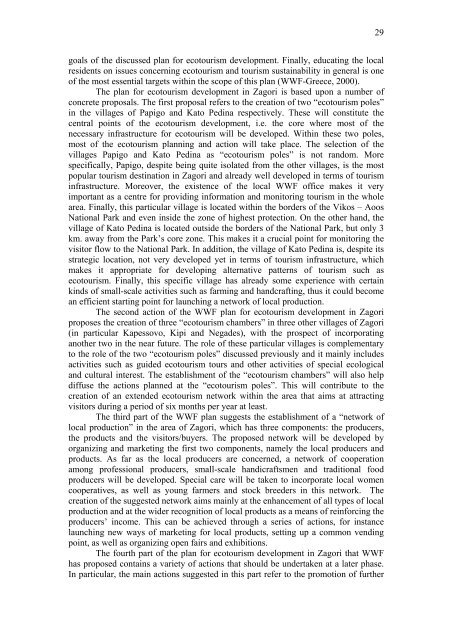Thesis title: âThe development of community-based ecotourism - lumes
Thesis title: âThe development of community-based ecotourism - lumes
Thesis title: âThe development of community-based ecotourism - lumes
You also want an ePaper? Increase the reach of your titles
YUMPU automatically turns print PDFs into web optimized ePapers that Google loves.
goals <strong>of</strong> the discussed plan for <strong>ecotourism</strong> <strong>development</strong>. Finally, educating the localresidents on issues concerning <strong>ecotourism</strong> and tourism sustainability in general is one<strong>of</strong> the most essential targets within the scope <strong>of</strong> this plan (WWF-Greece, 2000).The plan for <strong>ecotourism</strong> <strong>development</strong> in Zagori is <strong>based</strong> upon a number <strong>of</strong>concrete proposals. The first proposal refers to the creation <strong>of</strong> two “<strong>ecotourism</strong> poles”in the villages <strong>of</strong> Papigo and Kato Pedina respectively. These will constitute thecentral points <strong>of</strong> the <strong>ecotourism</strong> <strong>development</strong>, i.e. the core where most <strong>of</strong> thenecessary infrastructure for <strong>ecotourism</strong> will be developed. Within these two poles,most <strong>of</strong> the <strong>ecotourism</strong> planning and action will take place. The selection <strong>of</strong> thevillages Papigo and Kato Pedina as “<strong>ecotourism</strong> poles” is not random. Morespecifically, Papigo, despite being quite isolated from the other villages, is the mostpopular tourism destination in Zagori and already well developed in terms <strong>of</strong> tourisminfrastructure. Moreover, the existence <strong>of</strong> the local WWF <strong>of</strong>fice makes it veryimportant as a centre for providing information and monitoring tourism in the wholearea. Finally, this particular village is located within the borders <strong>of</strong> the Vikos – AoosNational Park and even inside the zone <strong>of</strong> highest protection. On the other hand, thevillage <strong>of</strong> Kato Pedina is located outside the borders <strong>of</strong> the National Park, but only 3km. away from the Park’s core zone. This makes it a crucial point for monitoring thevisitor flow to the National Park. In addition, the village <strong>of</strong> Kato Pedina is, despite itsstrategic location, not very developed yet in terms <strong>of</strong> tourism infrastructure, whichmakes it appropriate for developing alternative patterns <strong>of</strong> tourism such as<strong>ecotourism</strong>. Finally, this specific village has already some experience with certainkinds <strong>of</strong> small-scale activities such as farming and handcrafting, thus it could becomean efficient starting point for launching a network <strong>of</strong> local production.The second action <strong>of</strong> the WWF plan for <strong>ecotourism</strong> <strong>development</strong> in Zagoriproposes the creation <strong>of</strong> three “<strong>ecotourism</strong> chambers” in three other villages <strong>of</strong> Zagori(in particular Kapessovo, Kipi and Negades), with the prospect <strong>of</strong> incorporatinganother two in the near future. The role <strong>of</strong> these particular villages is complementaryto the role <strong>of</strong> the two “<strong>ecotourism</strong> poles” discussed previously and it mainly includesactivities such as guided <strong>ecotourism</strong> tours and other activities <strong>of</strong> special ecologicaland cultural interest. The establishment <strong>of</strong> the “<strong>ecotourism</strong> chambers” will also helpdiffuse the actions planned at the “<strong>ecotourism</strong> poles”. This will contribute to thecreation <strong>of</strong> an extended <strong>ecotourism</strong> network within the area that aims at attractingvisitors during a period <strong>of</strong> six months per year at least.The third part <strong>of</strong> the WWF plan suggests the establishment <strong>of</strong> a “network <strong>of</strong>local production” in the area <strong>of</strong> Zagori, which has three components: the producers,the products and the visitors/buyers. The proposed network will be developed byorganizing and marketing the first two components, namely the local producers andproducts. As far as the local producers are concerned, a network <strong>of</strong> cooperationamong pr<strong>of</strong>essional producers, small-scale handicraftsmen and traditional foodproducers will be developed. Special care will be taken to incorporate local womencooperatives, as well as young farmers and stock breeders in this network. Thecreation <strong>of</strong> the suggested network aims mainly at the enhancement <strong>of</strong> all types <strong>of</strong> localproduction and at the wider recognition <strong>of</strong> local products as a means <strong>of</strong> reinforcing theproducers’ income. This can be achieved through a series <strong>of</strong> actions, for instancelaunching new ways <strong>of</strong> marketing for local products, setting up a common vendingpoint, as well as organizing open fairs and exhibitions.The fourth part <strong>of</strong> the plan for <strong>ecotourism</strong> <strong>development</strong> in Zagori that WWFhas proposed contains a variety <strong>of</strong> actions that should be undertaken at a later phase.In particular, the main actions suggested in this part refer to the promotion <strong>of</strong> further29
















